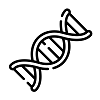15.3: Terms
( \newcommand{\kernel}{\mathrm{null}\,}\)
selected template will load here
This action is not available.

( \newcommand{\kernel}{\mathrm{null}\,}\)
| Accessory tissues | Tissue of the fruit that is from non-carpel origin, usually in epigynous and perigynous flowers — e.g., the flesh of an apple is hypanthium tissue and the ovary is the papery core that encloses the seed. |
| Aggregate fruit | Fruit formed from the ripened ovaries present in one flower with numerous simple carpels. |
| Dehiscent | Used to categorize fruits with seeds that separate from a dried pericarp. |
| Endocarp | Inner layer of the pericarp. |
| Exocarp | Outer layer of the pericarp. |
| Fruit (botanical sense) | Ripened ovary together with the seeds within the ovary. |
| Funiculus | Stalk that connects either an ovule or a seed to the placenta. |
| Indehiscent | Used to categorize fruits with seeds that are retained within the dried pericarp. |
| Mesocarp | Middle layer of the pericarp. |
| Multiple fruit | Fruit formed from the ripened ovaries from a cluster of flowers that are in close proximity in an inflorescence and that coalesce into one unit. |
| Pericarp | Ripened ovary wall; made up of three parts: exocarp, mesocarp, and endocarp. |
| Placenta | Part of an ovary where the funiculus attaches. |
| Seed | Ripened ovule containing a seed covering, food storage, and an embryo. |
| Simple fruit | Fruit formed from a flower with one carpel or multiple carpels fused together so that it looks like just one carpel. |

